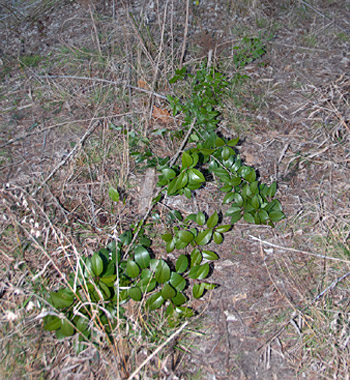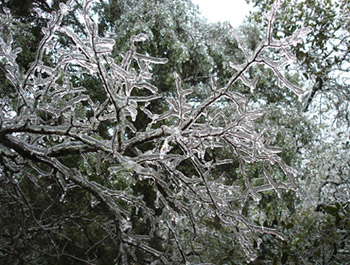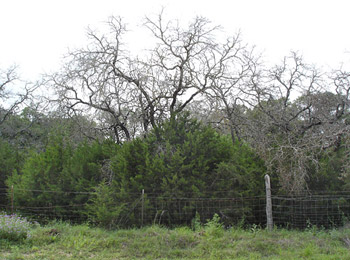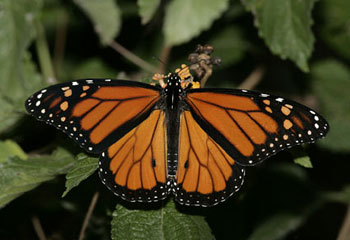Archive for 'Habitat' Category
No freeze. Temperature was 70 degrees today
- Saw one large and one smaller fox at feeding station
- Many sparrows at feeding station
- Cardinals very active
- Boise d'arc tree at bobcat draw
- Cleaned up fallen and broken branches lost from ice storm damage.
- Found first invasive Ligustrum tree along river trail. It was removed by pulling up.

Posted in
2007 Journal, Census, Habitat, Food
Maintenance to prepare for predicted arctic blast. Extended hard freeze next week.
- Charged batteries and added water to 2 6 volt solar batteries.
- All 3 well outlets were wrapped and left dripping
- Wrapped outside faucets and left lil' guzzler
- Replaced water pump at rain barn for lil' guzzler
Washed raccoon droppings from steps and chlorinated area to disinfect and reduce the spread of distemper disease.
Walked the land and sprayed all raccoon droppings throughout with chlorine and water solution.
Posted in
2007 Journal, Census, Habitat
Ice storm!

Caretaker's note: Texas is known for its unpredictable weather. The ice storm hit central Texas for three days between January 13th and 16th. This was one of the most severe ice storms recorded in Texas weather history. Reports of power outages were widespread. The storm affected a huge area in North America, from the Rio Grande valley to New England and Canada. watersto_jennystone damage consisted of broken limbs on large oak and juniper trees. The pretty winter wonderland melted on day 3. Walking through the woods was risky as huge ice chunks fell and tree limbs cracked under the weight of the ice. See more photos.
Found sick raccoon
Caretaker's note: A raccoon was seen listless in the road in the afternoon. Raccoons are normally nocturnal. It was picked up in a thick blanket with caretaker wearing thick gloves. There was no struggle indicating its illness. It was kept in a box in the house during the extreme cold weather and given food and water. The box was cleaned out daily until travel was possible after the ice storm.
It was taken to Wildlife Rescue where it was diagnosed with distemper. Raccoons can contract both feline and canine distemper. It had evidence of blindness and a limp. The eyes had a greenish color instead of black. It was given a distemper vaccine, which arrests the progress of the disease. It was left at Wildlife Rescue. Caretakers were advised to redesign the feeding area so that raccoons would not share feeding in close proximity to one another. Instead of one large pile of black oil sunflower seeds, the seed is scattered in a broad area.
Posted in
2007 Journal, Census, Habitat
Treated 21 oaks with fungicide for Oak Wilt.

Caretaker's note: Oak Wilt is a fungal disease that affects Live oaks, Shumard oaks, Red oaks (also called Spanish oaks), Black jack oaks and other members of the Red oak family. Experts have developed this Eight Step Program to correctly identify the problem. The fungus spreads through the root system and can be carried by beetles that are infected with the fungus. Proper pruning and careful wood storage can help prevent the spread of the disease. Oak Wilt, and other tree diseases are another reason to preserve Ashe juniper species in a woodland.
Treatment was provided by Paula Johnson's company Oak Wilt Specialists of Texas.
Posted in
2007 Journal, Habitat
Planted:
- 1 pound Buffalo grass seed
- Deer resistant mix (Native American Seed Farm)
- Butterfly Friendly Wildflower Mix Seedballs (Native Plant-Its)

Caretaker's note: This Monarch butterfly was flying south to its wintering grounds in
Mexico. They cannot survive freezing temperatures and in the fall
travel in large groups to warm winter climates. The
Oak Wilt scare on southeast corner of property. Texas Forest Service will visit for identification.
Posted in
2006 Journal, Census, Habitat
<< Previous Entries




